The month of February has been dedicated to the Black population of America since 1926. Starting out as only a week, called Negro History Week, created by Carter G. Woodson simply to align with Abraham Lincoln’s and Frederick Douglass’ birthdays has since grown into a month, Black History Month, filled with tangible dedications and celebrations for the history, hardships and achievements of the Black community in the United States.
As a predominantly white institution (PWI), it is important to educate the student body about the history of our country in the context of one of the most oppressed groups of people in the nation. The past month at Rockhurst has involved many events for students to participate in the celebration of Black History Month, and while the events have passed, they represent a strong presence of commemoration for the holiday, as well as anticipation for what is to come in future years on campus and in Kansas City.
Rockhurst’s Office of Diversity, Equity and Inclusion introduced opportunities ranging from a Visiting Scholar Lecture on the connection between Jesuit society and slavery, to a gala at the Black Archives of Mid-America, as well as a workshop led by Kansas City leadership discussing current social and political issues in the area.
While these events met the goal of honoring the contributions and sacrifices of Black Americans, it is essential to hear the perspective of students to understand the meaning of Black History Month and what that looks like at Rockhurst, so I interviewed Faizion Campbell and Nazrawit Zewdie from the Black Student Union’s (BSU) leadership.
When asking Campbell how Rockhurst students can get involved and why it is important to celebrate Black History Month on campus in general, he emphasized the importance of participation and appreciation:
“Get involved, you know, step in and have a conversation with us or another member of E-board. Also making sure you have an open mind and you’re interacting. That’s the best way.”
Participating in club meetings throughout the year, especially in during Black History Month is important for any student interested in celebration of Black culture and achievement, but I wanted to hear a more personal perspective on why the month of February is so important to the Black community. Additionally, I wanted to know how Rockhurst students, specifically, can celebrate the month and appreciate the holiday for what it represents. Campbell explained:
“At the end of the day, it’s an accomplishment that we’re here; everybody here has earned their spot. Everyone needs to have an open mind and be willing to experience things that aren’t the ‘regular’ for you. I don’t think there’s one specific way to celebrate, but it is important to have conversations with those that deal with issues that you might not experience.”
Since BSU is the voice for Black students on campus, I was interested in what could be considered controversial topic of how effective they think Rockhurst, as a PWI, is at making their students of color feel welcomed and appreciated. Rockhurst’s website emphasizes the goal of “creating an inclusive place for the whole community,” but how does that really translate into everyday life on campus, especially with a 2024 graduating class only consisting of 13.7% of Black or African American identifying students? The question is not if Rockhurst is diverse enough, but if university leadership is doing all that they can to identify as an institution that values all students and their backgrounds, and one that cares about their success.
“Recently we were trying to find information on the first black graduate of Rockhurst and working with archives, but we had trouble finding a lot of information. He graduated in 1951, but it took three books to find that out. He wasn’t even in a yearbook, we found it in the 100 years of Rockhurst book,” said Campbell. “It’s crazy to me how hard we had to dig to find information like that. I understand it was one student, but it was the first Black student. If our Black student population was able to see that face every day, then they would know why they’re here. It is such a monumental thing; it should be posted somewhere on campus.”
Campbell expressed confusion over how to find information on William Louis Blake, or the first black graduate of Rockhurst University in 1951. BSU had to outsource to “Rockhurst University: The First Hundred Years,” by Shirl Kasper. Especially during Black History Month, this information should be celebrated and expressed to the student body, if at least to emphasize the university’s appreciation of their black students.
This is not to say that my goal is to condemn university officials for not being active enough with diversity, equity and inclusion. The only goal I do have for writing this is to describe what February has looked like on campus this year. It would be incomplete to mention everything that was offered on and off campus for Black History Month without also highlighting possible areas of improvement. Improvement is the way forward, leaving behind patterns and practices that intentionally exclude certain groups or people.
When asked about this topic of improvement within Rockhurst, Zewdie emphasized the importance of physical diversity on campus not only with students, but faculty as well:
“We would like to see someone that looks like us teaching the courses we are taking. If there’s someone that looks like us that is in a higher position, leading by example, I think that would attract a lot of black students in this case.”
So, in terms of improvement within the topic of diversity and outreach, it seems that Rockhurst could benefit from the increase of marketing to potential black students or recruitment in general that focuses on the value of having a diverse student body.
To find a second opinion on improvement of marketing towards different groups of people, I interviewed adjunct professor of African American Literature and full-time Director of Inclusive Learning and Creative Outreach at the Kansas City Museum, Glenn North:
“I think if Rockhurst is interested in having a diverse student population, which would inevitably lead to more diverse offerings on campus, then there needs to be a discussion with the students of color about how to go out and effectively recruit other students, so diversity is then reflected in the student body and in the faculty.”
It was also important for North to note that to have a diverse and vibrant student body, you first need to have those same qualities in the faculty that are actively trying to recruit those students. If Rockhurst is interested in increasing the percentage of Black or African American graduates from 13.7%, perhaps the administration should think about hiring a higher percentage of faculty of color.
“As a museum professional, if I’m sitting at the table with my colleagues thinking ‘the kids are going to love this!’ and then they end up hating it, what was wrong? There weren’t any kids at the table,” said North.
If we put this into the context of admissions, or how to get more racially diverse applicants, that would mean talking to members of the student body that represent the feelings and ideas of racially diverse student groups already on campus. This is not at all a call to get angry at administration for being a predominantly white institution, that would make no sense as a white person myself. The point I am trying to make is that there are students and faculty on campus that represent hundreds of different stories, backgrounds and cultures that could prove to be beneficial to a university such as Rockhurst.
Everyone always says, “The more the merrier,” right? So why not apply that to our student body? College is supposed to be about broadening our perspectives and experiencing things and people we have not had the opportunity to before admission. Black History Month is a jumping point for educating others on the achievements of a specific culture, but there is still a long way to go on this campus and in this university.
“We are at a point where it’s important to look at all our different shared histories, so we have a full understanding of where we came from and how to chart a course for the future,” said North.








